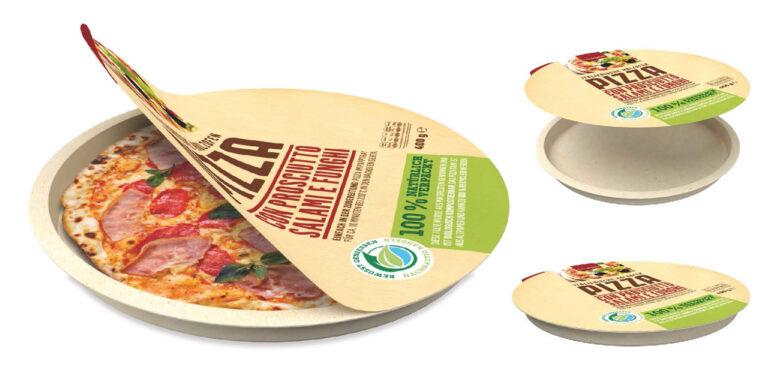 Frozen pizza in a round paper tear-open pack, beer in a bottle made of fibre? Is this the future of packaging, fibre-based protection for food instead of plastic? At the INGEDE Autumn Symposium in Schwedt, experts from industry, authorities and associations discussed possibilities to replace plastic which has fallen into disfavour due to lack of material recycling, the conditions for good recyclability and the limits. The speakers were largely in agreement: There is a need for action for new paper-based packaging with regard to the general conditions, consumer information and labelling, as well as for the further development of sorting systems and disposal routes. One had to move away from national to European solutions in the evaluation of packaging and its suitability for different recycling systems.
Frozen pizza in a round paper tear-open pack, beer in a bottle made of fibre? Is this the future of packaging, fibre-based protection for food instead of plastic? At the INGEDE Autumn Symposium in Schwedt, experts from industry, authorities and associations discussed possibilities to replace plastic which has fallen into disfavour due to lack of material recycling, the conditions for good recyclability and the limits. The speakers were largely in agreement: There is a need for action for new paper-based packaging with regard to the general conditions, consumer information and labelling, as well as for the further development of sorting systems and disposal routes. One had to move away from national to European solutions in the evaluation of packaging and its suitability for different recycling systems.
Paper, cardboard and cartons are the front-runners in Germany in terms of sustainability, with 89 percent material and more than ten percent energy recovery based on a renewable raw material. But too much potentially recyclable paper still ends up in packaging waste and residual waste, complained Robin Huesmann, CIO of the LEIPA Group. Papers with the Blue Angel and other environmental labels are produced in Schwedt from 100 percent recovered paper. Huesmann noted a lack of consumer information, but also often a lack of willingness to separate. Uncertainty also plays a role here: What do I do with the waxed wrapping paper, what about the water-repellent deep-freeze packaging? Is this waste paper?
Even if paper is currently in demand as a packaging material - it is not always enough as a barrier. "The devil is in the detail here," says Bernd Büsing, head of packaging at Nestlé Germany. Nestlé has developed "high-barrier papers" for several products, which contain up to ten percent of a polymer dispersion as a coating. Is the paper, composite, composite? Or a grey area? In Germany, in France? Büsing does not want to see such packaging marked as "plastic free". But the goal is: "We want to go into the blue bin.
Ten percent polymers in paper are "not advantageous from our point of view", confirmed Almut Reichart, environmental engineer at the Federal Environment Agency responsible for the pulp and paper industry. Avoiding packaging is the authority's top priority. She warned against an undifferentiated turning away from plastic: "Does paper still make sense when properties are required that paper cannot provide? Perhaps a film would be the better material after all, if it was then disposed of or recycled properly? Reichart certainly sees a need for adaptation in the methods and standards for assessing recyclability. Not only manufacturers and associations, but also the authorities and the central packaging register office must be involved, said Reichart. "I can see that we have to exercise our monitoring function more strongly here.
Peter Désilets of Pacoon also pointed out the great differences in the collection of packaging already in Europe. His Munich agency is concerned with the development of sustainable packaging and packaging strategies. Depending on the market and region, the assessment must take into account whether and how packaging is recycled, collected, composted or otherwise reused locally. Manufacturers of fibre packaging and recyclers are also called upon to establish recycling standards at a higher level internationally. There were possibilities to use intelligent combinations of plastic and fibres that could be easily separated again during recycling, as is already the case with some yoghurt pots.
The position of the paper industry was made clear by Martin Drews of the Association of German Paper Factories (VDP): the blue bin had proved its worth and had to be protected and implemented throughout Europe. Maintaining a high fibre quality in the cycle "must be our goal". Not everything that is made of paper can be recycled industrially - it is important to consider which colour, which varnish or which coatings are associated with it. Ideally, barriers should be easily separable from the fibres. He also drew attention to the yellow bin: this must be the way forward for new types of packaging that cannot be recycled in the main stream of waste paper. He warned against individual packaging manufacturers pushing ahead with new systems before their recycling had been clarified.
Prof. Samuel Schabel from the Institute for Paper Manufacture at the TU Darmstadt also lamented the multitude of new developments. Together with other partners, including the Papiertechnische Stiftung (PTS), Darmstadt is looking for a uniform evaluation method for the recyclability of packaging.
www.ingede.de


















































































